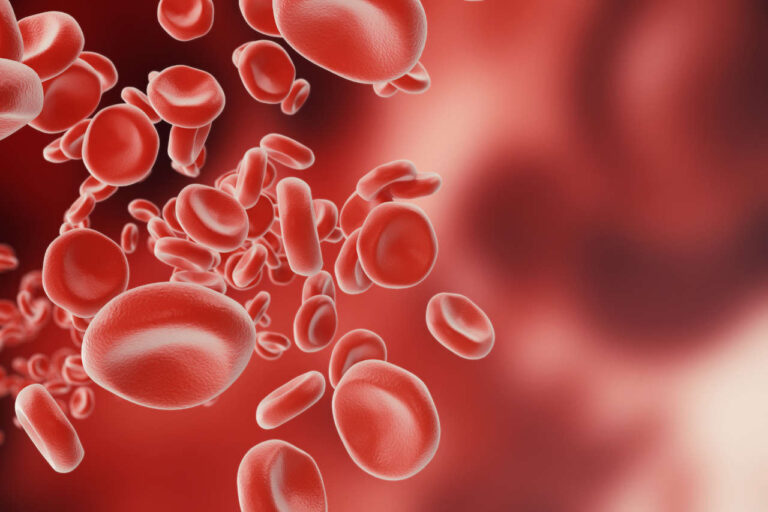
Hemophagocytic Lymphohistiocytosis (HLH) is a serious disease that can be life-threatening without an early diagnosis, immediate treatment, and intensive care. It is a rare immune disorder with uncontrolled hyperactivity of blood killer cells, especially T-cells (cytotoxic T-cells and natural killer cells) and macrophages. It is characterized by an exaggerated inflammatory response. The hyperactivated phagocytes (killer T cells) may attack other blood cells and consume the red cells (hemophagocytosis).
Get Copay Assistance
Speak to a SpecialistHLH is a rapidly progressive and potentially fatal condition that mostly affects infants and young people, but it may also occur in the older population.
Types
HLH can be classified as congenital or acquired.
Acquired HLH
Acquired HLH can occur in any age group. Most of the patients with acquired HLH are immunocompromised persons. Acquired HLH is often known as secondary HLH because it is mostly secondary to some other disease, such as:
- Bacterial, fungal, or viral infection like the one caused by Epstein-Barr virus or cytomegalovirus
- Carcinomas such as T-cell lymphoma or prostatic adenocarcinoma
- Hematological malignancies (i.e., leukemia)
- Autoimmune diseases such as those that attack bone marrow (i.e., rheumatologic diseases)
- Diseases that occur due to suppression of the immune system from the use of immunosuppressive drugs, etc.
Congenital HLH in Babies
Congenital or familial HLH is a genetic disorder that children inherit. The onset of familial HLH is at a very early age, often followed by a common infection. The newborn has a fever and increased activity of natural killer T cells characterized by a hyperinflammatory response with signs of pancytopenia (decreased number of the three types of blood cells–red blood cells, white blood cells, and platelets). There is fever along with hepatomegaly (liver enlargement) and splenomegaly (spleen enlargement). Congenital HLH has up to five subtypes with mutations in different genes concerned with the regulation of the production and activity of blood phagocytes. Congenital HLH is also known as “primary hemophagocytic lymphohistiocytosis.”
Causes
Research is ongoing to determine the exact cause of HLH. It is believed that it is caused by some post-infectious etiology that is yet to be determined. The proposed etiology is that infection, malignancy, or use of chemotherapeutic or immunosuppressive drugs attacks the cellular genetic material, especially in the bone marrow, which is the main production site of blood cells. This damage to the DNA causes the overproduction of certain cells (i.e., macrophages, cytotoxic T-cells, and natural killer T-cells). These phagocytes produce a hyperinflammatory response and attack the body’s other blood cells (i.e., red blood cells, platelets, granulocytes, etc.), which results in a pancytopenic (suppression of all three cell lines) condition.
Difference Between Leukemia and HLH
Research shows that there is a close link between myeloid leukemia and HLH disease. Leukemic persons may develop secondary HLH. Leukemia is also known as cancer of white blood cells. In this condition, there is increased production of abnormal young white blood cells (WBCs) that cannot function properly. Although there is an increased production of WBCs (especially macrophages and T-cells) in HLH, these are not abnormal cells; rather, they are hyperactive killer cells that kill bad cells and various pathogens. Due to their hyperactivity, they often attack the body’s own normal, good blood cells (which comprise the overall activity of the body’s immune system), resulting in symptoms that are common with leukemia.
Consult a Chemotherapy Specialist
Get Chemotherapy Treatment AssistanceSigns and Symptoms
HLH is a multisystem disorder affecting many organs such as the bone marrow, liver, spleen, brain, kidney, and heart, as well as general body tissues. Signs and symptoms you may encounter in HLH disease include the following:
Fever

Due to the hyperinflammatory response by the WBCs, there is an increased amount of circulating lymphokines such as interleukins and bradykinins that controls various bodily functions such as body temperature regulation, resulting in fever and accumulation of fluid in the tissues.
Cytopenia
Hyperactivated phagocytes start attacking normal functioning blood cells, resulting in low white cells that assist in warding off infections. Usually, there is a decrease in all types of blood cells, and this can affect different body functions. It is important that you get regular blood tests (i.e., CBC, etc.). Low levels of red blood cells may cause shortness of breath owing to decreased oxygen supply to the tissues. You may experience fatigue, dizziness, cold skin, irregular heartbeats, and pale, yellow skin. If you have symptoms of anemia, tell your physician. With the destruction of red cells, white cells, and platelets, the patient is at risk of anemia, shortness of breath, and fatigue, but more importantly, the patient is at risk of serious bacterial, fungal, viral infections, and serious bleeding.
Hepatosplenomegaly
Usually, the destruction of blood cells takes place in the bone marrow, liver, spleen, and lymph nodes. Phagocytes may accumulate in your spleen and liver, resulting in enlargement. This enlargement may become visible on the surface of the body in the abdominal region in severe cases. An enlarged liver may cause problems related to liver dysfunction, including jaundice (discussed later), abdominal pain, and vomiting.
Enlarged Lymph Nodes
Accumulation of phagocytes in lymph nodes causes their enlargement. Lymph nodes become swollen, and you may feel tenderness on the skin and pain.
Jaundice
The destruction of red blood cells produces bilirubin, the breakdown product of hemoglobin. This bilirubin is conjugated with salts like glucuronate to make it more soluble so that it can be easily excreted out of the body. In severe forms of destruction of red cells, bilirubin production increases along with decreased conjugation due to liver dysfunction. Bilirubin starts accumulating in the blood, resulting in jaundice.
Neurological Dysfunction
You may come across neurological symptoms such as encephalopathy. Neurological dysfunction is secondary to elevated levels of bilirubin, ferritin, triglycerides, and other cellular breakdown products. These affect brain growth and development. Hypertriglyceridemia can cause cerebral infarction secondary to cardiovascular problems.
Renal and Cardiac Problems
Elevated levels of unconjugated bilirubin can sometimes cause severe renal failure. It destroys renal tubules/nephrons by blocking them. Hypertriglyceridemia can cause cardiovascular problems such as arteriosclerosis, atherosclerosis, coronary artery blockage, and myocardial infarction.
Hyperferritinemia
Hyperferritinemia is an increased concentration of a plasma iron-binding protein named ferritin. The destruction of red blood cells increases the free iron content in the blood. This excess iron binds with ferritin and is converted to its storage form. Prolonged elevated iron content induces increased production of ferritin, causing hyperferritinemia.
HLH Treatment Info
Get Prior AuthorizationOther Symptoms
Some other common disease symptoms may occur, such as:
- Skin rash
- Nausea
- Headache
- Respiratory disorders
- Weight loss
Interestingly, there are a small number of cases of HLH in which solid tumors are reported. In some of the cases, tumors were associated with HLH and found in breast cancer, thyroid cancer, and prostatic adenocarcinoma.
Diagnosis
Diagnosis of HLH is very challenging because it has a very non-specific presentation. Due to its rarity and non-specific nature, many times, there is a delay in diagnosis. Often this disease is misdiagnosed, which leads to further complications and makes it even fatal.
According to research, prolonged fever, high ferritin levels of blood, hepatic dysfunction, cytopenias, and hepatosplenomegaly are the main features of HLH that make it different from other types of WBC cancers.
Disseminated intravascular coagulation and widespread inflammation is also seen in HLH patients. Mostly, sepsis is not present because of the hyperactivity of lymphocytes.
A very helpful tool in diagnosing HLH is blood picture. In some patients with HLH, when a blood picture was taken, it was clearly seen that hyperactive macrophages were destroying the body’s own red blood cells (hemophagocytosis), a major feature of the disease. Hyperfibrinogenemia in HLH patients was also seen in some research projects.
Treatment
As HLH is a potentially fatal disorder, treatment should be started as early as possible. Emergency medication should be administered to prevent the spread of the disease and help the body regain its crucial functions. The cause of the underlying disorder is then determined, and medication should be administered according to the cause.
Therapy is of two main types: medical and surgical.
Medical Treatment
First, medicines are used to control and slow down the spread of the disease. Medicinal control consists of a variety of drugs. Corticosteroids like dexamethasone are used to fight against inflammation. Immunotherapeutic medicines are used to strengthen the immune system of the patient. If HLH is secondary to some infection like bacterial, viral, or fungal infection, respective antibiotics are used (e.g., cyclosporine). Intravenous polyvalent immunoglobulins have also been used in some trials.
Then comes the most toxic chemicals, such as chemotherapy. Etoposide is one of the major chemotherapeutic medicines given to HLH patients. Other chemotherapy drugs include cyclophosphamide, doxorubicin, vincristine, and prednisone.
It should be remembered that all of these medicines are currently given on a trial basis. There is no specific medicine to cure HLH. Stem cell transplant or bone marrow transplant can confer a cure in some patients.
Autologous Stem Cell Transplant
Stem cell therapy has been performed in some cases, and the results obtained are encouraging. Stem cell therapy involves using healthy stem cells to treat or prevent disease. In this therapy, stem cells are taken from a healthy individual and transplanted into the bone marrow of the affected person.
Before therapy, there is a series of diagnostic tests to ensure the physical health of the patient to determine if the patient can withstand the transplantation process. The patient is then given chemotherapy that kills the defective bone marrow cells, and space is made available for new cells to be transplanted. This process is called “conditioning.” After successful conditioning, donor stem cells from a healthy, compatible donor are transplanted into the patient’s bone marrow. The patient is then kept under constant medical care.
Among the major limitations of this treatment is transplant rejection. A patient’s immune cells may destroy the newly transplanted cells. Another major issue is that this method can only cure the familial form of HLH. This method does not have an efficacy of 100%; instead, the rate of successful transplants is as low as 40%.
Get Copay Assistance
Speak to a SpecialistImportant Points To Remember
Here are a few important points to remember regarding treatment:
- Never self-medicate.
- Always consult your physician whenever you feel any symptoms. If you feel any enlargement in the abdominal area or in the neck, groin, breast, or axillary region, immediately seek medical help. Get imaging tests done such as ultrasound, CT scan, or MRI if required.
- The dose of a drug is specific for every person. Your doctor may increase or decrease your dose depending upon the severity of cancer, the appearance of adverse effects, or your body’s response to the drug.
- You have to follow the instructions given by your doctor strictly. The dose of a drug should not be more or less than what is prescribed. If you have accidentally skipped your dose, do not double dose. Instead, continue with the regular dosing schedule or consult your doctor if necessary.
- When you feel any discomfort, do not hesitate to tell your physician. Do not hide any symptoms. Brief your doctor adequately so that necessary arrangements can be made.
- You may feel acute or delayed nausea and vomiting once you start treatment because the drugs used to treat HLH are usually chemotherapeutic agents. If a physician prescribes you a drug, ask the physician about side effects and get guidelines to avoid any future emergency. Symptoms may usually disappear after a few hours or days after starting chemo. If not, contact your physician. Take care of your eating habits. Eat small amounts of food four to six times a day, and do not eat too much at one time. Maintain proper body hydration and take fluids throughout the day.
Survival Rate
Unfortunately, the survival rate of HLH is very low. Many adequately treated cases may have a high mortality rate. This is because of multiple factors (i.e., missed or delayed diagnosis, rapid and progressive spread of disease, no proven medication, low success rate of transplants, etc.). Without treatment, the patient may die within weeks or 1 – 2 months. Even with treatment and intensive care, a small fraction of patients (20% – 25%) have a life expectancy of 5 years.
Currently, a new medicinal protocol has been designed to treat HLH named “HLH-94” protocol. It consists of etoposide along with dexamethasone. This has resulted in an overall survival rate of 55% in some clinical trials.
The prognosis of HLH varies for patients with secondary HLH. Patients with HLH secondary to autoimmune diseases have a higher survival rate than those with HLH secondary to tumors like T-cell lymphoma.
Ongoing Research
Current research focuses on determining the exact cause of HLH. Trials for different medicinal protocols are being performed to find a specific treatment. The use of stem cell therapy, genetic engineering, and biotechnology in treating these kinds of diseases is an active area of research.
REFERENCES:
- Fisman, David N. (2000). “Hemophagocytic syndromes and infection”. Emerging Infect. Dis. 6 (6): 601–8. doi:10.3201/eid0606.000608. PMC 2640913. PMID 11076718.
- “Familial hemophagocytic lymphohistiocytosis: MedlinePlus Genetics”. medlineplus.gov. Retrieved 2021-01-24.
- Machowicz, Rafal; Janka, Gritta; Wiktor-Jedrzejczak, Wieslaw (2016-01-01). “Your critical care patient may have HLH (hemophagocytic lymphohistiocytosis)”. Critical Care. 20 (1): 215. doi:10.1186/s13054-016-1369-3. ISSN 1364-8535. PMC 4937543. PMID 27389585.
- Machowicz, Rafal; Basak, Grzegorz (2020-03-05). “How can an internal medicine specialist save a patient with hemophagocytic lymphohistiocytosis (HLH)?”. Polish Archives of Internal Medicine. 130 (5): 431–437. doi:10.20452/pamw.15226. PMID 32134401.
- Esteban, Ysabella M.; de Jong, Jill L. O.; Tesher, Melissa S. (1 August 2017). “An Overview of Hemophagocytic Lymphohistiocytosis”. Pediatric Annals. 46 (8): e309–e313. doi:10.3928/19382359-20170717-01. PMID 28806468.
- Giang HT, Banno K, Minh LH, Trinh LT, Loc LT, Eltobgy A, Tai LL, Khan A, Tuan NH, Reda Y, Samsom M. Dengue hemophagocytic syndrome: A systematic review and meta‐analysis on epidemiology, clinical signs, outcomes, and risk factors. Reviews in medical virology. 2018 Nov;28(6):e2005. https://onlinelibrary.wiley.com/doi/abs/10.1002/rmv.2005 https://doi.org/10.1002/rmv.2005
- Wysocki CA (December 2017). “Comparing hemophagocytic lymphohistiocytosis in pediatric and adult patients”. Current Opinion in Allergy and Clinical Immunology. 17 (6): 405–413. doi:10.1097/ACI.0000000000000405. PMID 28957822. S2CID 1143914













